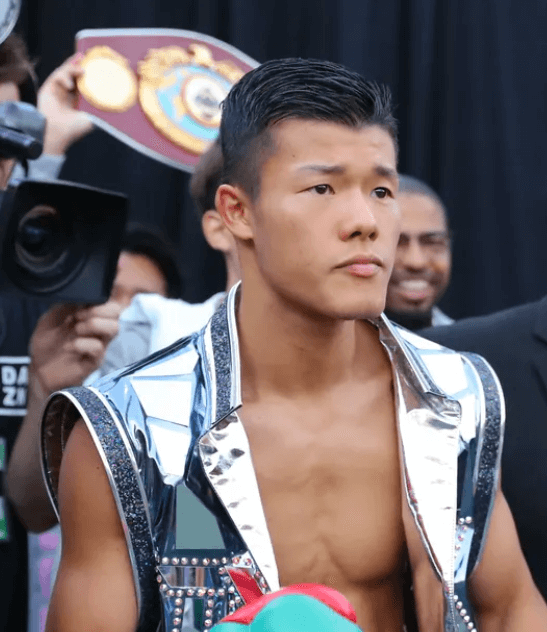Featured Articles
Tomoki Kameda, Japan’s “Little Mexican,” and the Glory Days of Japanese Boxing

Tomoki Kameda, Japan’s “Little Mexican,” and the Glory Days of Japanese Boxing
This is a golden era for Japanese boxing. Japanese fighters own all the meaningful hardware at 118 and 122 pounds. That’s eight belts in all, four of which are the property of undisputed super bantamweight kingpin Naoya Inoue, the first Japanese boxer in history to sit atop the most prestigious of the pound-for-pound lists.
Japan is also represented among the title-holders at 115 (Kosei Tanaka) and 112 (Seigo Yuri Akul) and has a potential featherweight title-holder in the mix in the form of Tomoki Kameda whose victory over Lerati Dlamini this past weekend was framed as an eliminator, making him next in line (in theory) to challenge the newly-crowned IBF featherweight champion Angelo Leo.
Kameda (pictured) has been around the block. Eleven years have passed since he won the WBO world bantamweight title in the Philippines with a unanimous decision over Namibia’s previously undefeated Paulus Ambunda and nine years have passed since he lost the strap in his third title defense, out-pointed by England’s Jamie McDonnell on a Matchroom card in Hidalgo, Texas.
McDonnell was the “A side” from the promoter’s want, but Kameda, who has had one of the most interesting careers of any active boxer, had the crowd in his corner. Hidalgo sits smack against the Mexican border. Virtually everyone there identifies as Latino or Hispanic.
In boxing, the term “Mexican style” is somewhat synonymous to “fan-friendly.” It suggests a high-pressure fighter whose best defense is a relentless offense. Tomoki Kameda took it a step further. At age 17, when he decided to turn pro, he took up residence in Mexico City. Fifteen of his first 23 pro fights were in Mexico, hence his nickname, “El Mexicanito,” a curious handle for a fighter from Osaka.
Kameda, who turned 33 last month, boasts a record of 42-4 (23 KOs). His losses were inflicted by McDonnell, twice, by Rey Vargas in a failed bid for Vargas’s super bantamweight title, and by the aforementioned Dlamini, a South African who upset Kameda in their first encounter. Both Kameda vs. Dlamini bouts, both staged in Japan, ended in split decisions, but there was no controversy when Kameda turned the tables in the rematch. The 116-111 tally submitted by visiting Nevada judge Robert Hoyle was considered the most accurate.
It’s a fair guess that a match between Kameda and Angelo Leo, should it transpire, would be held in Leo’s adopted hometown of Las Vegas. Kameda, for all his globetrotting, has fought in Las Vegas only once – back in 2014 on a Showtime card at the MGM Grand – but has spent many hours training there under the tutelage of Ismael Salas.
—
Over the next seven weeks, the Japanese boxing scene will be white-hot. The action begins on Tuesday of next week when Naoya Inoue defends his belts against TJ Doheny (26-4, 20 KOs). Hailing from Australia by way of Ireland, Doheny, a 37-year-old southpaw, has never been stopped.
There’s a first time for everything, as they say, and TJ Doheny’s first time will come on Sept. 3. (The bout will air on ESPN+, the capstone of a five-fight livestream that will commence in the wee hours of the morning in the U.S., specifically 2:30 am ET.)
On Sunday and Monday, Oct. 13 and 14, there will be back-to-back cards at Tokyo’s Ariake Arena.
On Oct. 13, Naoya’s younger brother Takuma Inoue (20-1, 5 KOs) defends his WBA 118-pound title against countryman Seiya Tsutsumi (11-0-2, KOs). Plus Kenshiro Teraji (23-1,14 KOs) moves up in weight to fight for the vacant WBA flyweight title with Nicaraguan veteran Cristofer Rosales (37-6, 22 KOs) in the opposite corner.
Oct. 14 marks the return of WBO bantamweight champion Junto Nakatani who is widely considered the best boxer from Japan not named Naoya Inoue. Nakatani (28-0, 21 KOs) is matched against mysterious Thai southpaw Tasana Salapat, aka Petch Sor Chitpattana, aka Petch CP Freshmart (76-1, 53 KOs). The supporting bouts include a match between WBO 118-pound title-holder Kosei Tanaka (20-1, 11 KOs) and South Africa’s obscure Phumelele Cafu (10-0-3, 8 KOs).
Looking ahead to 2025, there’s a good chance that Nakatani, who is tall for his weight class, will move up a notch to challenge the baby-faced “Monster,” Naoya Inoue. Barring any slip-ups along the way, that would be the biggest domestic showdown in the annals of Japanese boxing and something more. It would arouse the interest of boxing fans around the world, indicative of the heightened status of boxing in the Land of the Rising Sun.
To comment on this story in the Fight Forum CLICK HERE
-

 Featured Articles4 weeks ago
Featured Articles4 weeks agoAvila Perspective, Chap. 330: Matchroom in New York plus the Latest on Canelo-Crawford
-

 Featured Articles3 weeks ago
Featured Articles3 weeks agoVito Mielnicki Jr Whitewashes Kamil Gardzielik Before the Home Folks in Newark
-

 Featured Articles12 hours ago
Featured Articles12 hours agoResults and Recaps from New York Where Taylor Edged Serrano Once Again
-

 Featured Articles4 weeks ago
Featured Articles4 weeks agoCatching Up with Clay Moyle Who Talks About His Massive Collection of Boxing Books
-

 Featured Articles5 days ago
Featured Articles5 days agoFrom a Sympathetic Figure to a Pariah: The Travails of Julio Cesar Chavez Jr
-

 Featured Articles3 weeks ago
Featured Articles3 weeks agoMore Medals for Hawaii’s Patricio Family at the USA Boxing Summer Festival
-

 Featured Articles7 days ago
Featured Articles7 days agoCatterall vs Eubank Ends Prematurely; Catterall Wins a Technical Decision
-

 Featured Articles4 weeks ago
Featured Articles4 weeks agoRichardson Hitchins Batters and Stops George Kambosos at Madison Square Garden




















